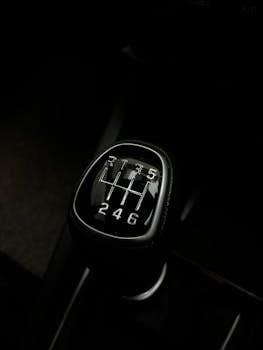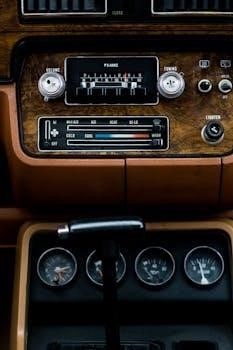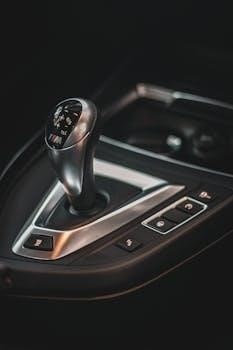
LS Manual Transmission⁚ An Overview
Manual transmissions offer enthusiasts enhanced control and driver engagement, which explains their continued popularity for LS swaps․ They provide a direct connection to the engine, enhancing the overall driving experience compared to automatics․

Advantages of Manual Transmissions in LS Swaps
Manual transmissions provide enhanced control, engaging drivers with the road․ They offer potential for improved fuel efficiency and durability, making them attractive for LS swaps․ The lower initial cost can also sway enthusiasts․
Enhanced Control and Driver Engagement
Manual transmissions in LS swaps offer a unique level of control, providing drivers with a more connected and engaging experience․ Unlike automatic transmissions, manuals require the driver to actively manage gear selection and clutch engagement, fostering a deeper sense of involvement in the driving process․
This direct control allows for precise manipulation of the engine’s power band, enabling drivers to tailor the vehicle’s performance to specific conditions and preferences․ Whether it’s maximizing acceleration on a track or navigating challenging terrain, the ability to choose the optimal gear offers a distinct advantage․
Furthermore, the tactile feedback and mechanical connection of a manual transmission can enhance the overall driving pleasure, creating a more visceral and rewarding experience․ The synchronization between driver and machine is a key element that keeps enthusiasts choosing manual transmissions․
Improved Fuel Efficiency (Potential)
While modern automatic transmissions have made strides in fuel efficiency, manual transmissions in LS swaps can still offer the potential for improved mileage under certain conditions․ The driver’s ability to select the optimal gear for a given situation allows for more efficient use of the engine’s power․
By avoiding unnecessary downshifts or upshifts, a skilled driver can minimize fuel consumption and maximize efficiency․ In situations where maintaining a constant speed is prioritized, such as highway driving, a manual transmission can provide a more direct and efficient connection between the engine and the wheels․
However, it’s important to note that the potential for improved fuel efficiency depends heavily on the driver’s skill and driving habits․ Aggressive driving or improper gear selection can negate any potential gains․ The simplicity of the manual transmission also lends itself to easier repairs, indirectly contributing to long-term efficiency․
Greater Durability and Lifespan
Manual transmissions are often perceived as having greater durability and a longer lifespan compared to their automatic counterparts․ This perception stems from their simpler design and fewer complex components․ With fewer intricate parts, there are fewer potential points of failure, leading to increased reliability․
Additionally, manual transmissions are generally easier and less expensive to repair than automatic transmissions․ The relative simplicity allows for a quicker diagnosis of issues, and replacement parts are often more readily available and affordable․ This ease of maintenance contributes to the overall longevity of the transmission․
Furthermore, the direct mechanical connection between the engine and the wheels in a manual transmission reduces the amount of stress placed on individual components․ Without the need for a torque converter or complex valve bodies, the transmission experiences less heat and wear, extending its lifespan․ This robustness makes them suitable for demanding applications;

Disadvantages of Manual Transmissions
Despite their advantages, manual transmissions have drawbacks․ These include a steeper learning curve, increased driver fatigue, especially in traffic, and diminishing availability in modern vehicles as automatics gain preference․
Learning Curve and Increased Fatigue
One significant disadvantage of manual transmissions is the learning curve․ Mastering the coordination of the clutch, gear changes, and throttle requires practice and skill․ New drivers may find it challenging to operate a manual transmission smoothly, leading to initial frustration․ Unlike automatic transmissions, which handle gear changes automatically, a manual transmission demands constant driver input․
This continuous engagement can lead to increased fatigue, particularly during long drives or in stop-and-go traffic․ Constantly depressing the clutch and shifting gears requires physical exertion, potentially causing discomfort in the leg and arm․
Moreover, incorrect gear selection can result in stalling or jerky movements, further adding to driver stress․ While experienced drivers may find manual transmissions second nature, beginners should be prepared for a learning period and the potential for increased fatigue, especially when starting out․
Less Convenience in Traffic
Manual transmissions can present a challenge in heavy traffic conditions․ The constant need to engage and disengage the clutch, shift gears, and modulate the throttle becomes tedious during stop-and-go situations․ This contrasts sharply with the ease of driving an automatic transmission, which requires only the use of the accelerator and brake pedals․
In dense traffic, drivers of manual transmission vehicles may experience leg fatigue from repeatedly depressing the clutch․ This can lead to discomfort and reduced concentration, potentially increasing the risk of accidents․ Furthermore, the need to coordinate multiple actions simultaneously can divert attention from the road, making it more difficult to react to sudden changes in traffic flow․
For daily commutes or frequent trips through congested areas, the convenience of an automatic transmission often outweighs the driver engagement offered by a manual transmission․ The reduced workload and simplified driving experience can make navigating traffic less stressful and more enjoyable․
Limited Availability in New Vehicles
The availability of new vehicles equipped with manual transmissions has significantly decreased in recent years; Automakers are increasingly focusing on automatic transmissions, including dual-clutch and continuously variable transmissions (CVTs), due to their improved fuel efficiency and performance capabilities․ As a result, finding a new car with a manual transmission can be challenging․
This limited availability can pose a problem for enthusiasts who prefer the driving experience of a manual transmission․ They may need to search extensively or consider purchasing a used vehicle to find a model that meets their preferences․ In some cases, manual transmissions are only offered on higher trim levels, which can increase the overall cost of the vehicle․
The declining popularity of manual transmissions reflects a shift in consumer preferences towards greater convenience and ease of use․ However, for those who value driver engagement and control, the limited availability of manual transmissions in new vehicles remains a significant disadvantage․

Common Manual Transmission Options for LS Engines
For LS engine swaps, popular manual options include the T56, known for its strength, and the AR5, offering a more budget-friendly alternative․ These transmissions provide different levels of performance and compatibility․
T56 Transmission
The T56 transmission stands out as a popular choice for LS swaps, often described as the “king” due to its robust design and widespread availability․ Originally found in vehicles like the Camaro and Firebird, its strength makes it well-suited for handling the power of an LS engine․ This six-speed manual offers a good balance between performance and drivability․
While the T56 is a common choice, it can sometimes be more expensive than other options․ However, its proven track record and readily available aftermarket support make it a reliable investment for many enthusiasts․ When considering a T56, it’s important to ensure compatibility with the specific LS engine being used․ Different versions of the T56 exist, each designed for specific power levels and applications․ Proper research and selection are essential for a successful swap․
AR5 Transmission
The AR5 transmission presents itself as a viable, and often more budget-friendly, alternative to the T56 for LS swaps․ Commonly found in vehicles like the Pontiac Solstice and Saturn Sky, the AR5 offers a five-speed configuration․ While not as robust as the T56, it can handle a reasonable amount of power, making it suitable for milder LS builds․
One of the key advantages of the AR5 is its affordability․ It’s often easier to source at a lower cost compared to the T56, making it an attractive option for budget-conscious enthusiasts․ However, it’s crucial to consider the power goals of the LS swap․ For high-horsepower applications, the AR5 may not be the best choice due to its lower torque capacity․ Adapting the AR5 to an LS engine may require careful planning and the use of adapter plates or custom parts․

Considerations for Choosing a Manual Transmission for an LS Swap
Selecting a manual transmission for an LS swap involves balancing factors like strength, dependability, cost, and availability․ Ensuring the chosen transmission can handle the LS engine’s power output is critical for longevity․
Strength and Dependability
When undertaking an LS swap, the manual transmission’s strength and dependability are paramount․ The chosen transmission must withstand the LS engine’s torque and power output to ensure longevity and prevent premature failure․ Consider the intended use of the vehicle․ A daily driver requires a different level of durability than a dedicated track car․ Researching the torque ratings and user reviews of various transmissions is essential․
Popular choices like the T56 are known for their robustness, but other options like the AR5 might be suitable for less demanding applications․ Exploring forums and online communities provides valuable insights into the real-world performance and reliability of different transmissions behind an LS engine․ Ultimately, selecting a transmission with a proven track record of strength and dependability ensures a successful and enjoyable LS swap experience․ Overbuilding is often preferable for peace of mind and future power upgrades․
Cost and Availability
Cost and availability play crucial roles in selecting a manual transmission for an LS swap․ The T56, a popular option, can be pricier than alternatives due to its demand and performance capabilities․ Conversely, transmissions like the AR5 might offer a more budget-friendly entry point, although they may require more adaptation work․
Availability also impacts the overall project cost and timeline․ Sourcing a readily available transmission minimizes delays and potential fabrication expenses․ Exploring local junkyards, online marketplaces, and specialized transmission vendors is essential to compare prices and assess availability․ Consider the cost of necessary adapters, shifters, and other supporting components when evaluating the overall budget․ Balancing performance needs with budgetary constraints is crucial in making a practical and informed decision․ Sometimes, a less expensive but readily available option is preferable to a high-end transmission that is difficult to source․